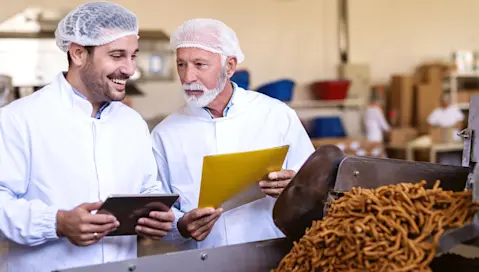4 Ways Batch Processing Helps Food and Beverage Businesses Cut Costs and Maximize Profitability
4 Ways Batch Processing Helps Food and Beverage Businesses Cut Costs and Maximize Profitability
4 Ways Batch Processing Helps Food and Beverage Businesses Cut Costs and Maximize Profitability
24 Aug 2022
John McCurdy
Lately, food and beverage manufacturing businesses like yours have been faced with the difficult proposition of keeping up in a sustained period of increased consumer demand while dealing with the elephant in the room that is rising costs. Ingredients, workforce, distribution—you name it, companies have been paying more for it.
In May, the Food and Agriculture Organization (FAO) reported a 40% year-on-year increase in the Food Price Index, a metric that tracks monthly changes in the international prices of commonly traded food companies. Meanwhile, labor and transportation costs are also soaring, particularly the latter, with JP Morgan & Chase Co. recently warning that disruptions have the per-barrel price of crude oil headed north of $185.
This puts the onus on your business and others in the sector to save money however possible and maximize efficiency without slipping in product quality or safety. In particular, two technologies can be leveraged in tandem to get the absolute most out of your operations and maximize profitability in these challenging times, those being batch processing and enterprise resource planning (ERP) software.
But what exactly is batch processing, and how is it incorporated into ERP solutions? We’re here to explain the background; cover four key benefits that unlock savings and boost profitability; and highlight how an industry-specific ERP with batch processing capabilities can help your organization thrive even with the higher expenses of today.
Defining Batch Processing
Interestingly enough, batch processing isn’t so named because it was developed specifically with batches of food products in mind. There are systems dedicated to batch management that serve that purpose, but batch processing is actually a method of program or process automation that first emerged as computers began to proliferate the business world in the 1960s.
Basically, batch processing works by recognizing when one process is complete, automatically pulling the necessary data to begin the next and then utilizing available resources optimally to continue the pre-planned sequence. In a food and beverage factory setting, this keeps your lines humming along without a hitch while freeing up your staff and eliminating the possibility of human error all at once.
With that general understanding established, let’s look at the four benefits of batch processing that help you cut costs and maximize profitability.
1. Greater Efficiency
When there’s less idle time between processes on your shop floor, you can produce more, day in and day out—it’s that simple. Because batch processing automatically moves your operations along to the next in your predetermined series of procedures, any pauses between your runs are minimal, and that helps you stay on track to meet your ambitious production and profitability goals.
For example, an ERP with batch processing technology could, at the conclusion of a run of one snack product, immediately alert employees and initiate the necessary sanitation and cleaning processes that must be conducted before beginning the next run of a different snack product. Once your personnel have completed their duties, the queue moves along accordingly, beginning production on the second variety of snacks.
2. Optimized Use of Human Capital
With an ERP equipped with batch processing technology, the parameters for your processes—which in the case of food and beverage manufacturing, includes fine-tuned levels for various ingredients, cooking temperatures and other precise settings—are all determined in advance. That means that your people aren’t tasked with these tedious and error-prone responsibilities.
Instead, they can concentrate on more mission-critical objectives, such as ensuring that all safety protocols are being followed, performing quality assurance checks and confirming that both inbound and outbound shipments are moving on schedule. That way, even though you’re facing higher costs, you’re getting more done with each shift and not cutting corners to make ends meet.
3. Better Standardization for Reduced Waste
Back on the matter of your recipes, you know they were crafted with care and perfected through multiple iterations by your dedicated research, development and marketing professionals. Just a slight imbalance in the mix of ingredients—or a cooking temperature that’s a smidgen off from the ideal level—can result in unsatisfactory products that must be scrapped, which represents a loss of resources in the materials already consumed in their production.
A food ERP solution with batch processing helps keep this kind of waste to a minimum through the standardization of your production processes, including the parameters to follow for each item in your lineup. When each setting has been preset and verified for accuracy, there’s minimal chance that a typo or lack of attention to detail on the part of a rushed staff member will ruin a run—instead, you have peace of mind that your investment in raw materials is going to good use.
4. Consistent Quality and Compliance
Now is not the time for your brand reputation to slip—customer loyalty and repeat buyers are an important source of profits. At the same time, you definitely want to avoid paying the cost of a product recall or noncompliance penalties if your finances are already pinched. Thankfully, the standardization discussed above helps further your quality assurance and compliance efforts so that you can feel more assured about your results.
By producing your goods in the same way every time via preset parameters automatically imported by your batch processing-equipped ERP, you get consistently excellent results and cement your business’s name as one to trust for great-tasting products. You can also be confident that no unlabeled allergens will contaminate your items, keeping them entirely safe to consume, and also know that materials won’t be compromised due to miscalculated cooking temperatures or times.
More to Love with Aptean Food & Beverage ERP
Here, we’ve outlined how automation through batch processing unlocks value and keeps unnecessary and avoidable costs to a minimum. The fact of the matter is that the incorporation of this technology is just one thing to appreciate about food ERP solutions, especially advanced food and and beverage software solutions like Aptean Food & Beverage ERP.
It starts with the establishment of a “single source of truth” that eliminates data siloes and facilitates agile, informed decision-making. By integrating with your electronic manufacturing equipment, our software updates in real time, meaning your database is reliably accurate and reflects the latest readings and performance results.
There are also dedicated features for the critical functions of inventory control, quality assurance, bidirectional traceability and recipe management, allowing you to truly own all vital areas of operations. Our own offering is a cut above, including further tools for expiration tracking, allergen control, catch weight management and financial analytics with robust visualizations for greater clarity and actionable insights.
What’s more, our food and beverage software solution, Aptean Food & Beverage ERP, has the added advantage of unique, industry-specific technology built on the Microsoft Dynamics 365 Business Central platform, which lends it a user-friendly and approachable interface. We also offer flexible cloud deployments that keep up-front costs down but security and flexibility at a maximum—plus, our solution recently won the prestigious 2022 Product Leadership Award in North American ERP Software for the Food and Beverage Industry from independent consulting firm Frost and Sullivan.
If all this sounds like something your food and beverage business could use to remain competitive in the face of rising costs, don’t hesitate to contact us today. You can also request a personalized demo to see the solution for yourself.
Related Content





How To Thrive During Food and Beverage Market Turbulence
Prioritizing modernization, optimization and a sound strategy is necessary for success in the food and beverage industry. Increase operational agility in a continually changing (and often unpredictable) manufacturing landscape.



